What We’re Reading: April 21
Review: Rubisco activases: AAA+ chaperones adapted to enzyme repair
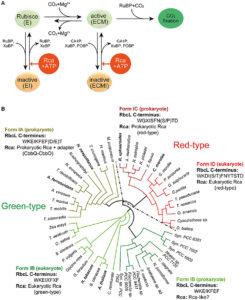 Rubisco, the fundamental enzyme required for photosynthetic carbon fixation, is susceptible to inactivation by the inhibitory binding of various metabolites. Rubisco activases (Rca’s) are enzymes that remodel Rubisco and facilitate the elimination of the inhibitor. All photosynthetic organisms have Rubisco activases that share a AAA+ domain. Bhat et al. review the structure and function of Rca enzymes found in prokaryotes and plants, and note that “the diversity of these enzymes provides a fascinating example of convergent evolution.” Front. Mol. Biosci. 10.3389/fmolb.2017.00020 Tags: Biochemistry, Bioenergy
Rubisco, the fundamental enzyme required for photosynthetic carbon fixation, is susceptible to inactivation by the inhibitory binding of various metabolites. Rubisco activases (Rca’s) are enzymes that remodel Rubisco and facilitate the elimination of the inhibitor. All photosynthetic organisms have Rubisco activases that share a AAA+ domain. Bhat et al. review the structure and function of Rca enzymes found in prokaryotes and plants, and note that “the diversity of these enzymes provides a fascinating example of convergent evolution.” Front. Mol. Biosci. 10.3389/fmolb.2017.00020 Tags: Biochemistry, Bioenergy
Review: The unfolded protein response in development, defense, and stress
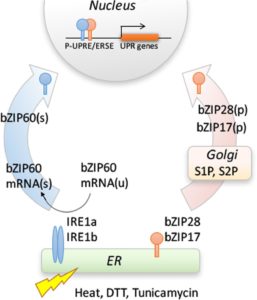 The unfolded protein response (UPR) is a eukaryote-wide signalling pathway in which unfolded proteins in the ER (often caused by abiotic stress) initiate signals transduced to the nucleus that lead to the expression of stress-response genes. Bao and Howell review the UPR in plants. They describe two ways that signals can move from the ER to the nucleus; in one, alternative RNA splicing of a bZIP transcription factor leads to the protein accumulating in the nucleus, and in the other different bZIP transcription factors are released from the ER and relocated to the nucleus. The review also discusses evidence, mostly from analysis of mutants, of the role of the UPR in hormone biology (auxin and brassinosteroids), vegetative and reproductive growth (including heat stress effects on pollen), and responses to pathogens. Front. Plant Sci. 10.3389/fpls.2017.00344 Tags: Biochemistry, Cell Biology, Signals and Responses
The unfolded protein response (UPR) is a eukaryote-wide signalling pathway in which unfolded proteins in the ER (often caused by abiotic stress) initiate signals transduced to the nucleus that lead to the expression of stress-response genes. Bao and Howell review the UPR in plants. They describe two ways that signals can move from the ER to the nucleus; in one, alternative RNA splicing of a bZIP transcription factor leads to the protein accumulating in the nucleus, and in the other different bZIP transcription factors are released from the ER and relocated to the nucleus. The review also discusses evidence, mostly from analysis of mutants, of the role of the UPR in hormone biology (auxin and brassinosteroids), vegetative and reproductive growth (including heat stress effects on pollen), and responses to pathogens. Front. Plant Sci. 10.3389/fpls.2017.00344 Tags: Biochemistry, Cell Biology, Signals and Responses
Update: The multiple signals that control tuber formation
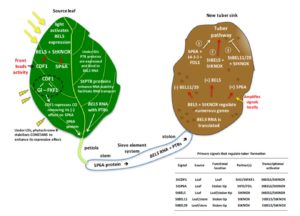 Potato is an important food crop, but unlike most of the other major foods, it is a tuber, not a seed. Classic studies showed that there is a mobile, photoperiod-induced signal that moves from the shoot to the stolen tip (an underground, stem-like structure) to initiate tuberization. Experimental studies point to three factors as key in the onset of tuberization. Hannapel et al. review recent evidence for these tuberization signals. StSP6A (an orthologue of “florigen”, FLOWERING LOCUS T) is a phloem-mobile protein produced in the leaf under favorable conditions. StCDF1 functions in the leaf to enhance expression of StSP6A. StBEL5 moves as a phloem-mobile RNA from leaf to stolon, where it is translated and serves as a transcription factor. This review also discusses processes upstream and downstream of these three key factors, and unresolved issues. Plant Physiol. 10.1104/pp.17.00272 Tags: Gene Regulation, Growth Regulation, Physiology
Potato is an important food crop, but unlike most of the other major foods, it is a tuber, not a seed. Classic studies showed that there is a mobile, photoperiod-induced signal that moves from the shoot to the stolen tip (an underground, stem-like structure) to initiate tuberization. Experimental studies point to three factors as key in the onset of tuberization. Hannapel et al. review recent evidence for these tuberization signals. StSP6A (an orthologue of “florigen”, FLOWERING LOCUS T) is a phloem-mobile protein produced in the leaf under favorable conditions. StCDF1 functions in the leaf to enhance expression of StSP6A. StBEL5 moves as a phloem-mobile RNA from leaf to stolon, where it is translated and serves as a transcription factor. This review also discusses processes upstream and downstream of these three key factors, and unresolved issues. Plant Physiol. 10.1104/pp.17.00272 Tags: Gene Regulation, Growth Regulation, Physiology
Review: Tale of the Huanglongbing disease pyramid in the context of the citrus microbiome ($)
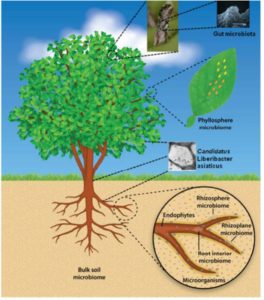 Huanglongbing (HLB or Citrus Greening Disease) has caused enormous economic losses in major citrus production areas, including Florida. The Huanglongbing disease pyramid consists of the bacteria Liberibacters, citrus psyllid vectors (insects), citrus hosts, and the environment in which they all exist. The authors complement existing reviews of Liberibacters and citrus plant interactions by reviewing the literature on Liberibacter/psyllid interaction, psyllid/plant interaction, and on the citrus microbiome component of this pyramid. This review highlights changes in proportions and amounts of microbial species in the rhizosphere, rhizoplane, endosphere, and phyllosphere when citrus becomes infected with HLB. Reviewing what is known of the complexity of the HLB disease pyramid bolsters the argument that successful management strategies must take this complex web of reciprocal interactions into account. (Summary by Megan Lynch) Phytopathology 10.1094/PHYTO-12-16-0426-RVW Tags: Biotic Interactions
Huanglongbing (HLB or Citrus Greening Disease) has caused enormous economic losses in major citrus production areas, including Florida. The Huanglongbing disease pyramid consists of the bacteria Liberibacters, citrus psyllid vectors (insects), citrus hosts, and the environment in which they all exist. The authors complement existing reviews of Liberibacters and citrus plant interactions by reviewing the literature on Liberibacter/psyllid interaction, psyllid/plant interaction, and on the citrus microbiome component of this pyramid. This review highlights changes in proportions and amounts of microbial species in the rhizosphere, rhizoplane, endosphere, and phyllosphere when citrus becomes infected with HLB. Reviewing what is known of the complexity of the HLB disease pyramid bolsters the argument that successful management strategies must take this complex web of reciprocal interactions into account. (Summary by Megan Lynch) Phytopathology 10.1094/PHYTO-12-16-0426-RVW Tags: Biotic Interactions
Non-random domain organization of the Arabidopsis genome at the nuclear periphery
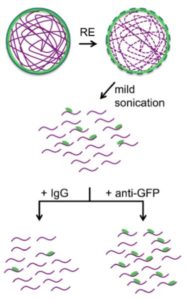 Chromatin in the nucleus is not randomly arranged. In animal cells, studies have identified an enrichment for non-genic or silenced DNA near the nuclear envelope, as demonstrated by its association with the nuclear lamin proteins. Plants don’t have proteins like animal lamins, but a few envelope-associated proteins have been identified. Bi et al. used a modified chromatin-immunoprecipitation method to identify genomic regions associated with a protein that accumulates at the nuclear envelope, NUP1 (fused to GFP). The authors found that, similar to findings from animal cells, the nuclear periphery is enriched for repressed chromatin, although there are some interesting and notable exceptions. Genome Bio. 10.1101/gr.215186.116 Tags: Molecular Biology, Gene Regulation
Chromatin in the nucleus is not randomly arranged. In animal cells, studies have identified an enrichment for non-genic or silenced DNA near the nuclear envelope, as demonstrated by its association with the nuclear lamin proteins. Plants don’t have proteins like animal lamins, but a few envelope-associated proteins have been identified. Bi et al. used a modified chromatin-immunoprecipitation method to identify genomic regions associated with a protein that accumulates at the nuclear envelope, NUP1 (fused to GFP). The authors found that, similar to findings from animal cells, the nuclear periphery is enriched for repressed chromatin, although there are some interesting and notable exceptions. Genome Bio. 10.1101/gr.215186.116 Tags: Molecular Biology, Gene Regulation
A circRNA from SEPALLATA3 regulates splicing of its cognate mRNA through R-loop formation ($)
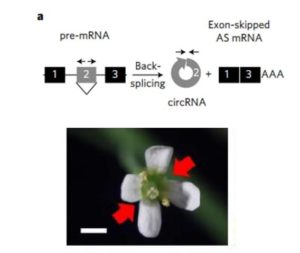 Circular RNAs (circRNAs) are a recently discovered form of stable, covalently-closed RNA found in all domains of eukaryotic life. The origins and functions of circRNAs have been under intensive investigation. Often, circRNAs consist of one or more exons, often corresponding to skipped exons from genes that are alternatively spliced (AS), but the relationship between circRNA and AS has been unclear. Conn et al. started with 12 abundant Arabidopsis circRNAs which they matched to their cognate genes, 11 of which showed exon skipping. They then focused on genes where the AS variant was known to have biological function. When they highly expressed a circRNA corresponding to exon 6 of SEP3, the resulting plants showed an increase in the exon 6-skipped AS variant, and a decrease in sepal number. The authors showed hybridization between the circRNA and the corresponding gene, and suggest that this interaction promotes the recruitment of splicing factors and the production of the AS variant. Nature Plants 10.1038/nplants.2017.53 Tags: Molecular Biology, Gene Regulation
Circular RNAs (circRNAs) are a recently discovered form of stable, covalently-closed RNA found in all domains of eukaryotic life. The origins and functions of circRNAs have been under intensive investigation. Often, circRNAs consist of one or more exons, often corresponding to skipped exons from genes that are alternatively spliced (AS), but the relationship between circRNA and AS has been unclear. Conn et al. started with 12 abundant Arabidopsis circRNAs which they matched to their cognate genes, 11 of which showed exon skipping. They then focused on genes where the AS variant was known to have biological function. When they highly expressed a circRNA corresponding to exon 6 of SEP3, the resulting plants showed an increase in the exon 6-skipped AS variant, and a decrease in sepal number. The authors showed hybridization between the circRNA and the corresponding gene, and suggest that this interaction promotes the recruitment of splicing factors and the production of the AS variant. Nature Plants 10.1038/nplants.2017.53 Tags: Molecular Biology, Gene Regulation
Exploiting maize genetic diversity: Metabolomic, enzyme activity profiling, and metabolic modelling to link leaf physiology to kernel yield ($)
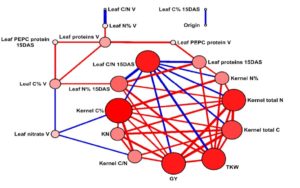 The path from genome to phenome is difficult to predict. Cañas et al. tried to identify biochemical markers that are correlated with kernel yield that could be selected for in breeding. Specifically, they collected data from metabolomics, enzyme activity assays and metabolic modeling, taken during the vegetative phase and the grain filling state 15 days after silking (15 DAS), from 19 maize lines. Interestingly, in this sample pool representing broad genetic distance, they observed “only a slight relationship between the genetic distance of the 19 lines and their enzyme activities 15 DAS”. A strong correlation between grain yield and kernel C and N was observed, and higher levels of enzymes involved in C4 photosynthesis and nitrogen assimilation into amino acids during vegetative growth was also a positive indicator of yield. Plant Cell 10.1105/tpc.16.00613 Tags: Genetics, Metabolism, Systems Biology
The path from genome to phenome is difficult to predict. Cañas et al. tried to identify biochemical markers that are correlated with kernel yield that could be selected for in breeding. Specifically, they collected data from metabolomics, enzyme activity assays and metabolic modeling, taken during the vegetative phase and the grain filling state 15 days after silking (15 DAS), from 19 maize lines. Interestingly, in this sample pool representing broad genetic distance, they observed “only a slight relationship between the genetic distance of the 19 lines and their enzyme activities 15 DAS”. A strong correlation between grain yield and kernel C and N was observed, and higher levels of enzymes involved in C4 photosynthesis and nitrogen assimilation into amino acids during vegetative growth was also a positive indicator of yield. Plant Cell 10.1105/tpc.16.00613 Tags: Genetics, Metabolism, Systems Biology
LOCALIZER: Subcellular localization prediction of both plant and effector proteins in the plant cell
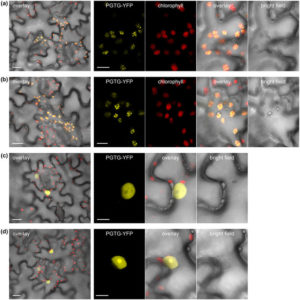 Proteins carry sequence tags that are read by cellular machineries that deliver the proteins to their proper destinations, which include the nucleus, mitochondria and plastid. Many pathogen effector proteins have acquired such targeting tags too, but these effector tags can sometimes be cryptic to bioinformatics tools trained on native plant proteins. Sperschneider et al. have developed a tool with an improved ability to identify effector protein localization tags (it does pretty well with plant proteins too). The tool, called LOCALIZER, can be found at http://localizer.csiro.au/. Sci. Reports 10.1038/srep44598 Tags: Biotic Interactions, Cell Biology, Computational Biology
Proteins carry sequence tags that are read by cellular machineries that deliver the proteins to their proper destinations, which include the nucleus, mitochondria and plastid. Many pathogen effector proteins have acquired such targeting tags too, but these effector tags can sometimes be cryptic to bioinformatics tools trained on native plant proteins. Sperschneider et al. have developed a tool with an improved ability to identify effector protein localization tags (it does pretty well with plant proteins too). The tool, called LOCALIZER, can be found at http://localizer.csiro.au/. Sci. Reports 10.1038/srep44598 Tags: Biotic Interactions, Cell Biology, Computational Biology
The preprophase band of microtubules controls the robustness of division orientation in plants ($)
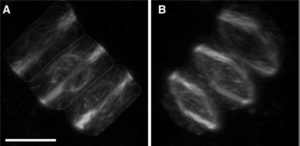 Every student of plant cell biology learns that the future plane of cell division is marked very early in mitosis by the preprophase band (PPB), a band of microtubules that forms around the periphery of the cell. Prior experimental studies have suggested that the PPB is necessary for proper placement of the mitotic spindle and the division plane. Schaefer et al. examined trm mutants (TON1 Recruiting Motif) in which the PPB fails to form; TON1 is part of a protein network involved in microtubule dynamics. In these PPB-deficient mutants, the average plane of cell division is indistinguishable from wild type, but there is greater variance; “such effects on variance without affecting the mean are characteristic of a process acting as a stabilizer rather than as a primary determinant,” thus suggesting a new interpretation of the role of the PPB. Science 10.1126/science.aal3016 Tags: Cell Biology
Every student of plant cell biology learns that the future plane of cell division is marked very early in mitosis by the preprophase band (PPB), a band of microtubules that forms around the periphery of the cell. Prior experimental studies have suggested that the PPB is necessary for proper placement of the mitotic spindle and the division plane. Schaefer et al. examined trm mutants (TON1 Recruiting Motif) in which the PPB fails to form; TON1 is part of a protein network involved in microtubule dynamics. In these PPB-deficient mutants, the average plane of cell division is indistinguishable from wild type, but there is greater variance; “such effects on variance without affecting the mean are characteristic of a process acting as a stabilizer rather than as a primary determinant,” thus suggesting a new interpretation of the role of the PPB. Science 10.1126/science.aal3016 Tags: Cell Biology
Selective autophagy of BES1 mediated by DSK2 balances plant growth and survival
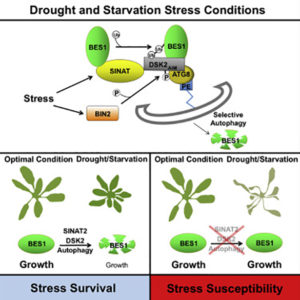 Brassinosteroid (BR) signaling promotes growth and development by regulating gene expression through the BES1 and BZR1 transcription factors. Nolan et al. show how plants balance growth and stress tolerance by cross-talk between the BR and autophagy pathways. Under environmental stresses, BES1 is targeted for autophagic degradation by direct interaction with the autophagy receptor protein DSK2. DSK2 is phosphorylated by BIN2 kinase, which is a negative regulator of BR signaling, and this phosphorylation enhances DSK2 interaction with the ATG8 autophagy protein. Under drought stress, atg7-2 and DSK RNAi plants show BES1 accumulation and a hypersensitive phenotype, which is supported by levels of differentially-expressed genes from RNA sequencing. Double DSK2 and BES1 RNAi plants have a restored drought survival phenotype and decreased BES1 protein levels. Under fixed-carbon starvation, the RING E3 ubiquitin ligase SINAT2 directly interacts with DSK2 for degrading BES1 10.1016/j.devcel.2017.03.013. In the same issue of Developmental Cell, Yang et al. report on interactions between SINAT proteins and BES1 10.1016/j.devcel.2017.03.014. (Summary by Daniel Czerny). Tags: Abiotic Interactions, Cell Biology, Growth Regulation, Signals and Responses
Brassinosteroid (BR) signaling promotes growth and development by regulating gene expression through the BES1 and BZR1 transcription factors. Nolan et al. show how plants balance growth and stress tolerance by cross-talk between the BR and autophagy pathways. Under environmental stresses, BES1 is targeted for autophagic degradation by direct interaction with the autophagy receptor protein DSK2. DSK2 is phosphorylated by BIN2 kinase, which is a negative regulator of BR signaling, and this phosphorylation enhances DSK2 interaction with the ATG8 autophagy protein. Under drought stress, atg7-2 and DSK RNAi plants show BES1 accumulation and a hypersensitive phenotype, which is supported by levels of differentially-expressed genes from RNA sequencing. Double DSK2 and BES1 RNAi plants have a restored drought survival phenotype and decreased BES1 protein levels. Under fixed-carbon starvation, the RING E3 ubiquitin ligase SINAT2 directly interacts with DSK2 for degrading BES1 10.1016/j.devcel.2017.03.013. In the same issue of Developmental Cell, Yang et al. report on interactions between SINAT proteins and BES1 10.1016/j.devcel.2017.03.014. (Summary by Daniel Czerny). Tags: Abiotic Interactions, Cell Biology, Growth Regulation, Signals and Responses
Pea border cell maturation and release involve complex cell wall structural dynamics
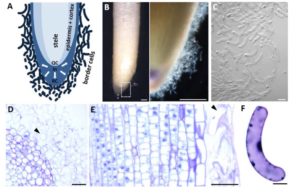 Border cells form at the root tip and are shed during growth, protecting the sensitive root apex from damage as it pushes through the soil. Mravec et al. investigated the cell wall chemistry, carbohydrate distributioion and expression of cell-wall modifying genes to determine the mechanism by which border cells separate from their neighboring cells. Their data indicate that during separation there is a dissolution of a part of the cell wall enriched in homogalacturonan, rhamnogalacturonan I backbone, and arabinan. Separation also might be facilitated by differential wall elongation mediated by extensin and xyloglucan. Plant Physiol. 10.1104/pp.16.00097 Tags: Cell Biology, Growth Regualtion
Border cells form at the root tip and are shed during growth, protecting the sensitive root apex from damage as it pushes through the soil. Mravec et al. investigated the cell wall chemistry, carbohydrate distributioion and expression of cell-wall modifying genes to determine the mechanism by which border cells separate from their neighboring cells. Their data indicate that during separation there is a dissolution of a part of the cell wall enriched in homogalacturonan, rhamnogalacturonan I backbone, and arabinan. Separation also might be facilitated by differential wall elongation mediated by extensin and xyloglucan. Plant Physiol. 10.1104/pp.16.00097 Tags: Cell Biology, Growth Regualtion
Sugar suppression of aquaporin expression and leaf hydraulics ($)
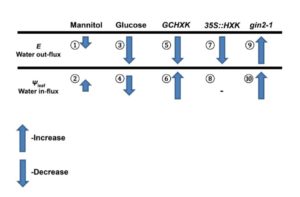 Sugar is a signal as well as an energy source, and plants monitor sugar levels to maintain an appropriate growth rate and rate of photosynthesis. A new study by Kelly et al. points to a role for sugars in the expression and activity of plasma-membrane (PIP) aquaporins. Aquaporins (AQP) are membrane channels for water and carbon dioxide, and their regulated activity contributes to hydraulic conductivity. The authors examined the responses of wildtype and mutant or overexpression lines of Arabidopsis to sugar treatments. They found that elevated sugar levels (or hexokinase expression) decreased the expression of PIP AQPs and leaf conductance, and speculate that sugar signals the plant to decrease its transpiration rate (which is determined in part by the need for CO2 uptake for photosynthesis and sugar production). Plant J. 10.1111/tpj.13568 Tags: Physiology, Transport
Sugar is a signal as well as an energy source, and plants monitor sugar levels to maintain an appropriate growth rate and rate of photosynthesis. A new study by Kelly et al. points to a role for sugars in the expression and activity of plasma-membrane (PIP) aquaporins. Aquaporins (AQP) are membrane channels for water and carbon dioxide, and their regulated activity contributes to hydraulic conductivity. The authors examined the responses of wildtype and mutant or overexpression lines of Arabidopsis to sugar treatments. They found that elevated sugar levels (or hexokinase expression) decreased the expression of PIP AQPs and leaf conductance, and speculate that sugar signals the plant to decrease its transpiration rate (which is determined in part by the need for CO2 uptake for photosynthesis and sugar production). Plant J. 10.1111/tpj.13568 Tags: Physiology, Transport
Malate-dependent Fe accumulation is a critical checkpoint in the root developmental response to low phosphate
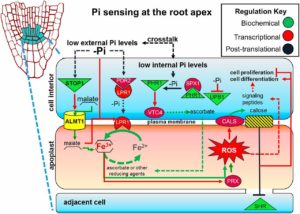 Phosphate is a limiting nutrient in soil and not very mobile, so roots respond strongly to low Pi soils by the cessation of elongation of the primary root with accompanying stimulation of lateral root and root hair production. Previously, the accumulation of iron (Fe3+) in the apoplast of root meristem cells with accompanying callose deposition was shown to contribute to growth arrest. Javier Mora-Macías et al. used a genetic approach to identify low-Pi insensitive (lpi) mutants, in which primary root growth does not arrest. They identified mutations in two genes involved in malate efflux (STOP1 and ALMT1) as contributing to this process; malate efflux has previously been shown to confer protection against toxic levels of aluminum in the soil. These results highlight the importance of oranic acid extrusion in multiple root nutrient responses. Proc. Natl. Acad. Sci. USA 10.1073/pnas.1701952114 Tags: Abiotic Interactions, Growth Regulation
Phosphate is a limiting nutrient in soil and not very mobile, so roots respond strongly to low Pi soils by the cessation of elongation of the primary root with accompanying stimulation of lateral root and root hair production. Previously, the accumulation of iron (Fe3+) in the apoplast of root meristem cells with accompanying callose deposition was shown to contribute to growth arrest. Javier Mora-Macías et al. used a genetic approach to identify low-Pi insensitive (lpi) mutants, in which primary root growth does not arrest. They identified mutations in two genes involved in malate efflux (STOP1 and ALMT1) as contributing to this process; malate efflux has previously been shown to confer protection against toxic levels of aluminum in the soil. These results highlight the importance of oranic acid extrusion in multiple root nutrient responses. Proc. Natl. Acad. Sci. USA 10.1073/pnas.1701952114 Tags: Abiotic Interactions, Growth Regulation
Mutation in sorghum LOW GERMINATION STIMULANT 1 alters strigolactones and causes Striga resistance
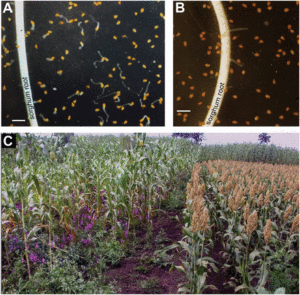 Strigolactones are hormones that control shoot architecture and signals that promote interactions with arbuscular mycorrhizal fungi and promote germination of detrimental parasitic weeds such as Striga asiatica and Striga hermonthica. Gobena et al. mapped and cloned a sorghum gene, LOW GERMINATION STIMULANT 1 (LGS1), previously identified as conferring less stimulation of germination in Striga. LGS1 encodes a sulfotransferase, and plants carrying the mutant allele show an altered strigolactone profile. Specifically, they produce less 5-deoxystrigol and more orobanchol, which has a different stereochemistry. Orobanchol performs SL hormone functions and promotes colonization by AM fungi, but does not stimulate Striga germination. These insights can provide a new approach to combat the devastating effects of Striga on crop productivity. Proc. Natl. Acad. Sci. USA 10.1073/pnas.1618965114 Tags: Applied Plant Biology, Biotic Interactions, Genetics
Strigolactones are hormones that control shoot architecture and signals that promote interactions with arbuscular mycorrhizal fungi and promote germination of detrimental parasitic weeds such as Striga asiatica and Striga hermonthica. Gobena et al. mapped and cloned a sorghum gene, LOW GERMINATION STIMULANT 1 (LGS1), previously identified as conferring less stimulation of germination in Striga. LGS1 encodes a sulfotransferase, and plants carrying the mutant allele show an altered strigolactone profile. Specifically, they produce less 5-deoxystrigol and more orobanchol, which has a different stereochemistry. Orobanchol performs SL hormone functions and promotes colonization by AM fungi, but does not stimulate Striga germination. These insights can provide a new approach to combat the devastating effects of Striga on crop productivity. Proc. Natl. Acad. Sci. USA 10.1073/pnas.1618965114 Tags: Applied Plant Biology, Biotic Interactions, Genetics
Regulation of strigolactone biosynthesis by gibberellin signaling
 In a screen for chemicals that regulate strigolactone (SL) levels in rice, Ito et al. found that gibberellins suppress SL biosynthesis. This effect depends on the gibberellin signaling module, and involves a decrease in expression level of SL-biosynthetic genes. Furthermore, GA treated rice exuded less SL into the soil, and Striga seed germination frequency was reduced as well as Striga parasitism. Thus, “tissue-specific modification of GA signaling can be used to control root parasitic weed infection.” Plant Physiol. 10.1104/pp.17.00301 Tags: Biotic Interactions, Signals and Responses
In a screen for chemicals that regulate strigolactone (SL) levels in rice, Ito et al. found that gibberellins suppress SL biosynthesis. This effect depends on the gibberellin signaling module, and involves a decrease in expression level of SL-biosynthetic genes. Furthermore, GA treated rice exuded less SL into the soil, and Striga seed germination frequency was reduced as well as Striga parasitism. Thus, “tissue-specific modification of GA signaling can be used to control root parasitic weed infection.” Plant Physiol. 10.1104/pp.17.00301 Tags: Biotic Interactions, Signals and Responses
Arabidopsis leucine-rich repeat receptor-like kinase NILR1 is required for induction of innate immunity to parasitic nematodes
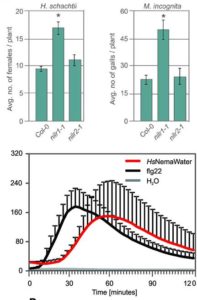 Plant parasitic nematodes, including root-knot nematodes and cyst nematodes, cause extensive damage and loss to many crops. Nematodes elicit a pathogen-triggered immunity (PTI) defense response, but the molecular basis for this response has not been previously characterized. Mendy et al. identified a leucine-rich repeat receptor-like kinase NILR1 that recognizes an as yet unknown nematode protein to elicit a PTI response; loss-of-function nilr1 mutants are hypersusceptible to several types of nematodes. NILR1 is conserved in dicotyledonous plants and provides a new approach for crop protection against nematodes. PLOS Pathogen. 10.1371/journal.ppat.1006284 Tags: Biotic Interactions, Genetics
Plant parasitic nematodes, including root-knot nematodes and cyst nematodes, cause extensive damage and loss to many crops. Nematodes elicit a pathogen-triggered immunity (PTI) defense response, but the molecular basis for this response has not been previously characterized. Mendy et al. identified a leucine-rich repeat receptor-like kinase NILR1 that recognizes an as yet unknown nematode protein to elicit a PTI response; loss-of-function nilr1 mutants are hypersusceptible to several types of nematodes. NILR1 is conserved in dicotyledonous plants and provides a new approach for crop protection against nematodes. PLOS Pathogen. 10.1371/journal.ppat.1006284 Tags: Biotic Interactions, Genetics
Rapid breeding of parthenocarpic tomato plants using CRISPR/Cas9
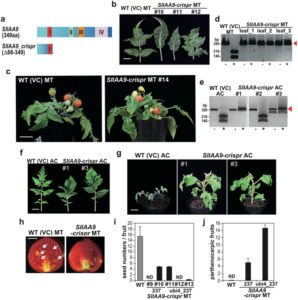 Most fruits form after pollination, making their production vulnerable to pollinator presence. Parthenocarpy is the development of fruit that occurs in the absence of pollination. Genes that enable parthenocarpy have been identified, including a tomato gene involved in auxin responses SlIAA9. Ueta et al. used CRISPR/Cas9 to efficiently engineer parthenocarpy into two commercial tomato varieties. One outcome of this research could be sustained fruit yields even when pollinator populations decline. Sci. Reports. 10.1038/s41598-017-00501-4 Tags: Applied Plant Biology, Genetics, Growth Regulation
Most fruits form after pollination, making their production vulnerable to pollinator presence. Parthenocarpy is the development of fruit that occurs in the absence of pollination. Genes that enable parthenocarpy have been identified, including a tomato gene involved in auxin responses SlIAA9. Ueta et al. used CRISPR/Cas9 to efficiently engineer parthenocarpy into two commercial tomato varieties. One outcome of this research could be sustained fruit yields even when pollinator populations decline. Sci. Reports. 10.1038/s41598-017-00501-4 Tags: Applied Plant Biology, Genetics, Growth Regulation
Long-term trends in the intensity and relative toxicity of herbicide use
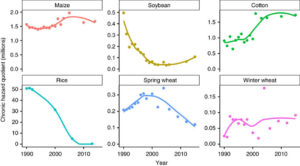 “Weeds are a fact of life for farmers around the world,” writes Kniss in this analysis of herbicide-use trends. He stresses the limitation of reports that measure only the weight of herbicides used, as there is tremendous variation in the toxicity of different herbicides. He shows that although herbicide use intensity has risen, for many crops both chronic (accumulating) and acute (leading to death) herbicide toxicity has decreased. He discusses the contribution of the widely-used but lower-toxicity glyphosate to this trend, as well as the impact of glyphosate-resistant GM crops on herbicide use. Nature Comms. 10.1038/ncomms14865 Tags: Applied Plant Biology, Environmental Plant Biology
“Weeds are a fact of life for farmers around the world,” writes Kniss in this analysis of herbicide-use trends. He stresses the limitation of reports that measure only the weight of herbicides used, as there is tremendous variation in the toxicity of different herbicides. He shows that although herbicide use intensity has risen, for many crops both chronic (accumulating) and acute (leading to death) herbicide toxicity has decreased. He discusses the contribution of the widely-used but lower-toxicity glyphosate to this trend, as well as the impact of glyphosate-resistant GM crops on herbicide use. Nature Comms. 10.1038/ncomms14865 Tags: Applied Plant Biology, Environmental Plant Biology
Genomic inferences of domestication events are corroborated by written records in Brassica rapa ($)
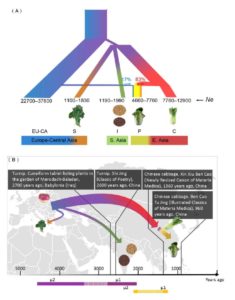 There are many subspecies of Brassica rapa [including turnip (subsp. rapa) pak choi (subsp. chinensis) and Chinese cabbage (subsp. pekinensis)] but the relationships between the subspecies has remained uncertain. Qi et al. sequenced 143 accessions, including some subspecies for the first time. They then used genomics approaches to develop a phylogeny. They corroborate their molecular findings with written records (the domestication of B. rapa has occurred within the timespan of written history), making this an intriguing article for students interested in the history of agriculture as well as population genomics. Molec. Ecol. 10.1111/mec.14131 Tags: Education and Outreach, Evolution, Genetics, Genomics
There are many subspecies of Brassica rapa [including turnip (subsp. rapa) pak choi (subsp. chinensis) and Chinese cabbage (subsp. pekinensis)] but the relationships between the subspecies has remained uncertain. Qi et al. sequenced 143 accessions, including some subspecies for the first time. They then used genomics approaches to develop a phylogeny. They corroborate their molecular findings with written records (the domestication of B. rapa has occurred within the timespan of written history), making this an intriguing article for students interested in the history of agriculture as well as population genomics. Molec. Ecol. 10.1111/mec.14131 Tags: Education and Outreach, Evolution, Genetics, Genomics
.




Leave a Reply
Want to join the discussion?Feel free to contribute!